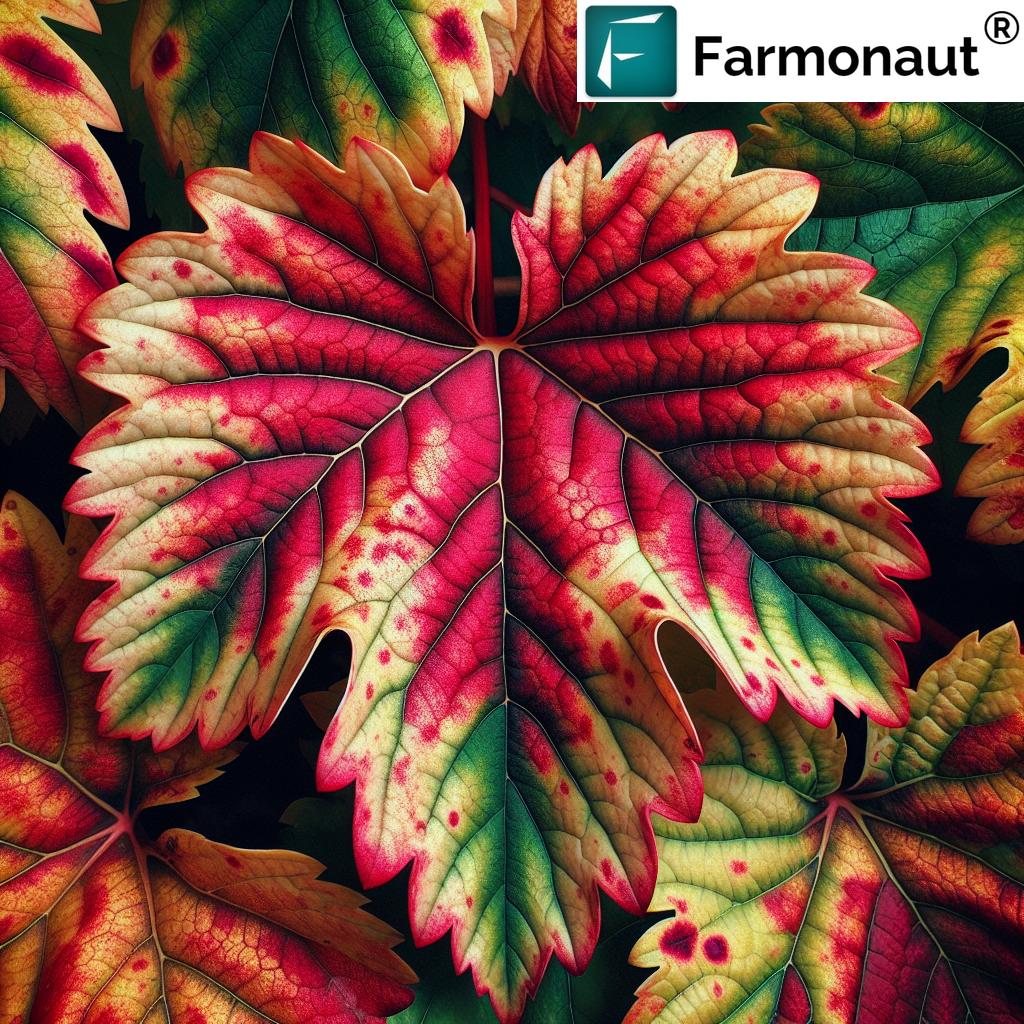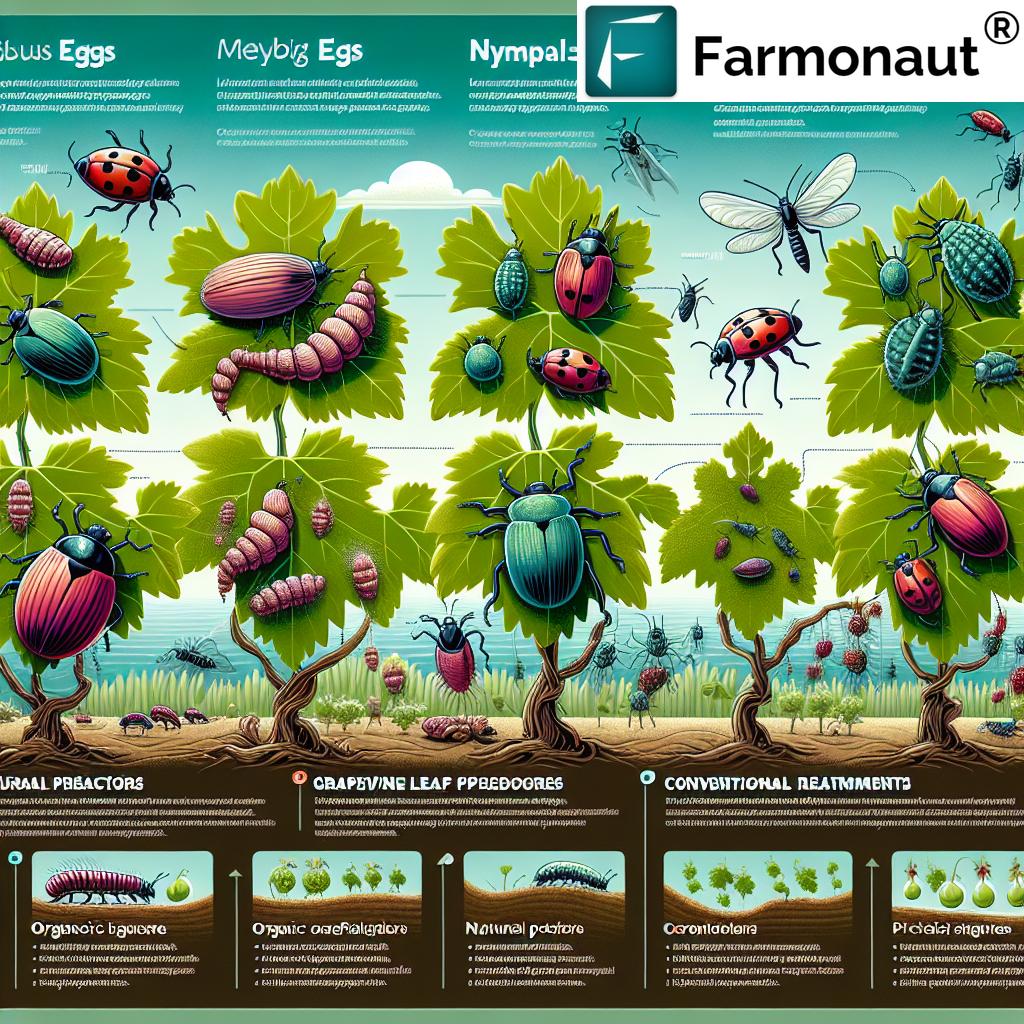Grapevine Leafroll Disease: Organic and Conventional Treatments for Virus-Infected Vines

In the world of viticulture, grapevine leafroll disease (GLD) stands as one of the most significant challenges facing vineyard managers and wine producers. This complex virus disease affects grapevines worldwide, causing substantial economic losses and compromising the quality of grapes and wine. At Farmonaut, we recognize the importance of addressing this issue and are committed to providing cutting-edge solutions to help vineyard owners combat this persistent threat.
Understanding Grapevine Leafroll Disease
Grapevine leafroll disease is caused by a group of viruses known as Grapevine Leafroll-associated Viruses (GLRaVs). These viruses belong to the family Closteroviridae and can be transmitted through various means, including vegetative propagation, grafting, and insect vectors such as mealybugs and soft scale insects.
Symptoms of Grapevine Leafroll Disease
The symptoms of GLD can vary depending on the grape variety, virus strain, and environmental conditions. However, some common signs include:
- Downward rolling of leaves, particularly in older leaves
- Reddening of leaves in red grape varieties
- Yellowing of leaves in white grape varieties
- Delayed ripening of fruit
- Reduced sugar content in berries
- Decreased vine vigor and yield
It’s important to note that symptoms may not be visible until late in the growing season, making early detection challenging without advanced monitoring techniques.
The Impact of Grapevine Leafroll Disease on Vineyards
The effects of GLD on vineyards can be severe and long-lasting. Infected vines often experience:
- Reduced photosynthetic activity
- Decreased berry size and cluster weight
- Lower fruit quality, including reduced sugar content and altered flavor profiles
- Shortened lifespan of vines
- Increased susceptibility to other pests and diseases
These factors combined can lead to significant economic losses for vineyard owners and wine producers, emphasizing the need for effective management strategies.
Transmission and Spread of Grapevine Leafroll Disease
Understanding how GLD spreads is crucial for developing effective control measures. The primary modes of transmission include:
- Vegetative Propagation: The use of infected plant material for grafting or propagation is a major contributor to the spread of GLD.
- Insect Vectors: Mealybugs and soft scale insects can acquire the virus from infected vines and transmit it to healthy plants.
- Mechanical Transmission: While less common, the virus can potentially spread through contaminated pruning tools or other vineyard equipment.
The role of mealybugs in virus transmission is particularly significant. These small, soft-bodied insects feed on plant sap and can efficiently spread the virus as they move from vine to vine.
Detection and Diagnosis of Grapevine Leafroll Disease
Early detection of GLD is crucial for effective management. Traditional methods of detection include:
- Visual inspection for symptoms
- Serological tests (ELISA)
- Molecular techniques (PCR)
However, these methods can be time-consuming and may not detect the virus in its early stages. This is where advanced technology, such as Farmonaut’s satellite-based monitoring system, can play a crucial role.

Farmonaut’s Satellite Monitoring for Early Detection
At Farmonaut, we utilize cutting-edge satellite technology to monitor vineyard health and detect potential issues before they become visible to the naked eye. Our system offers:
- Regular, high-resolution imagery of vineyards
- Advanced vegetation indices to assess plant health
- AI-powered analysis to identify anomalies and potential disease hotspots
- Early warning alerts for vineyard managers
By leveraging this technology, vineyard owners can detect and address GLD infections much earlier, potentially saving entire blocks of vines from infection.
Comparison: Traditional Vineyard Monitoring vs. Farmonaut Satellite System
| Feature | Traditional Monitoring | Farmonaut Satellite System |
|---|---|---|
| Early Disease Detection | Limited to visible symptoms | Detects stress before visible symptoms appear |
| Pest Monitoring | Manual scouting required | AI-powered detection of pest-related stress |
| Vine Stress Identification | Subjective, based on visual inspection | Objective, based on multispectral data analysis |
| Coverage Area | Limited by human resources | Entire vineyard covered regularly |
| Frequency of Assessment | Periodic, labor-intensive | Continuous monitoring with regular updates |
| Data Analysis | Manual, time-consuming | Automated, AI-powered insights |
| Cost-Effectiveness | Labor-intensive, higher long-term costs | Scalable, lower long-term costs |
As demonstrated in the comparison table, Farmonaut’s satellite monitoring system offers significant advantages over traditional monitoring methods, particularly in early detection and comprehensive vineyard health assessment.
Management Strategies for Grapevine Leafroll Disease
Managing GLD requires a multi-faceted approach that combines preventive measures with targeted interventions. We’ll explore both organic and conventional methods for controlling this challenging disease.
Preventive Measures
- Use of Clean Plant Material: Always source grapevine material from certified virus-free nurseries.
- Vector Control: Implement strategies to manage mealybug populations in the vineyard.
- Sanitation: Regularly clean and disinfect pruning tools and other equipment.
- Isolation: Plant new vineyards away from potentially infected older plantings.
- Monitoring: Regularly inspect vines for symptoms and utilize advanced monitoring tools like Farmonaut’s satellite system.
Organic Control Methods
For vineyards following organic practices, several methods can help manage GLD:
- Biological Control: Introduce natural predators of mealybugs, such as ladybugs or lacewings.
- Cultural Practices: Remove infected leaves and prune affected parts of the vine.
- Organic Pesticides: Use approved organic substances like neem oil or insecticidal soaps to control vector populations.
- Cover Crops: Plant species that repel mealybugs or attract their natural predators.
- Vine Health Promotion: Improve overall vine health through proper nutrition and soil management to enhance natural resistance.
Conventional Control Methods
For vineyards using conventional approaches, additional options are available:
- Chemical Pesticides: Apply approved insecticides to control mealybug populations. Always follow local regulations and guidelines for pesticide use.
- Systemic Insecticides: Use products that can be absorbed by the plant to provide longer-lasting protection.
- Vine Removal: In severe cases, removing and destroying infected vines may be necessary to prevent further spread.
- Soil Fumigation: This can help control soil-borne pests that may contribute to virus spread.
Innovative Approaches to GLD Management
At Farmonaut, we’re constantly exploring new technologies and methods to enhance vineyard management. Some innovative approaches we’re monitoring include:
- RNA Interference (RNAi): This emerging technology could potentially silence the genes responsible for virus replication in plants.
- CRISPR Gene Editing: Research is underway to develop grapevine varieties with enhanced resistance to leafroll viruses.
- Nanotechnology: Nanoparticles could be used to deliver targeted treatments to infected vines.
- IoT Sensors: Advanced sensors can monitor vine health in real-time, complementing satellite data for even more precise management.
While these technologies are still in development, they show promise for future GLD management strategies.
The Role of Vineyard Design in Disease Management
The layout and design of a vineyard can significantly impact its susceptibility to GLD and other diseases. Consider the following factors:
- Row Orientation: Proper orientation can improve air circulation and reduce humidity, creating less favorable conditions for pests and diseases.
- Vine Spacing: Adequate spacing between vines can improve sunlight penetration and air movement.
- Trellis Systems: Choose systems that promote good canopy management and facilitate monitoring and pest control.
- Buffer Zones: Establish non-vine areas between blocks to limit disease spread.
Farmonaut’s satellite monitoring can help optimize vineyard design by providing detailed insights into microclimates and vine performance across different areas of the vineyard.
The Economics of Grapevine Leafroll Disease Management
Managing GLD effectively requires a significant investment of time and resources. However, the cost of inaction can be far greater. Consider the following economic factors:
- Yield Reduction: GLD can reduce yields by 15-40% in severely affected vineyards.
- Quality Impact: Reduced sugar content and altered flavor profiles can significantly decrease the value of harvested grapes.
- Vine Lifespan: Infected vines may need to be replaced earlier, increasing long-term costs.
- Treatment Costs: Ongoing management of GLD requires investment in monitoring, pest control, and potentially vine replacement.
By implementing proactive management strategies and leveraging advanced technologies like Farmonaut’s satellite monitoring, vineyard owners can minimize these economic impacts and protect their long-term profitability.
The Future of Grapevine Leafroll Disease Management
As we look to the future, several trends are likely to shape the management of GLD:
- Precision Viticulture: Advanced technologies like Farmonaut’s satellite monitoring will become increasingly integral to vineyard management, allowing for more targeted and efficient disease control.
- Integrated Pest Management (IPM): A holistic approach combining multiple control strategies will become the standard for sustainable vineyard management.
- Resistant Varieties: Ongoing research into disease-resistant grapevine varieties may provide new options for vineyards in high-risk areas.
- Climate Change Adaptation: As climate patterns shift, vineyard managers will need to adapt their disease management strategies to new environmental conditions.
- Blockchain Traceability: Technologies like blockchain could enhance the traceability of grapevine stock, helping to prevent the spread of infected plant material.
Conclusion
Grapevine leafroll disease presents a significant challenge to vineyard managers and wine producers worldwide. However, with a combination of vigilant monitoring, proactive management strategies, and innovative technologies, it is possible to mitigate its impact and maintain healthy, productive vineyards.
At Farmonaut, we’re committed to supporting vineyard owners in their fight against GLD and other challenges. Our advanced satellite monitoring system provides early detection capabilities and comprehensive vineyard health assessments, enabling more effective and timely interventions.
By staying informed about the latest research and management techniques, and by leveraging cutting-edge technologies, vineyard managers can protect their vines, preserve grape quality, and ensure the long-term sustainability of their operations.
FAQs about Grapevine Leafroll Disease
- Q: Can grapevine leafroll disease be cured?
A: Currently, there is no cure for GLD once a vine is infected. Management focuses on prevention and controlling the spread of the disease. - Q: How long can a vine remain productive with GLD?
A: This varies depending on the severity of infection and management practices, but infected vines generally have a shorter productive lifespan and may need to be replaced earlier than healthy vines. - Q: Are some grape varieties more resistant to GLD?
A: While no varieties are completely immune, some show greater tolerance to GLD. Research is ongoing to develop more resistant varieties. - Q: How effective are organic methods in controlling GLD?
A: Organic methods can be effective when implemented as part of a comprehensive management strategy, particularly in preventing the spread of the disease through vector control. - Q: Can GLD spread from wild grapevines to cultivated vineyards?
A: Yes, wild grapevines can serve as reservoirs for the virus and associated vectors, potentially spreading the disease to nearby cultivated vineyards.
For more information on how Farmonaut can help you manage grapevine leafroll disease and other vineyard challenges, visit our application page or explore our API services. You can also download our mobile app for Android or iOS to access our services on the go.
For developers interested in integrating our satellite and weather data into their own applications, please refer to our API documentation.